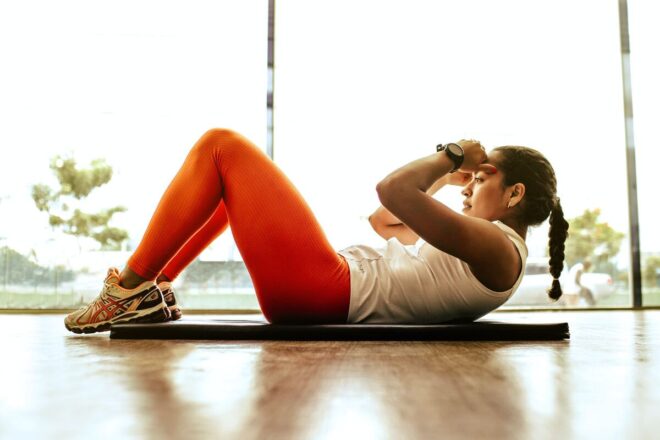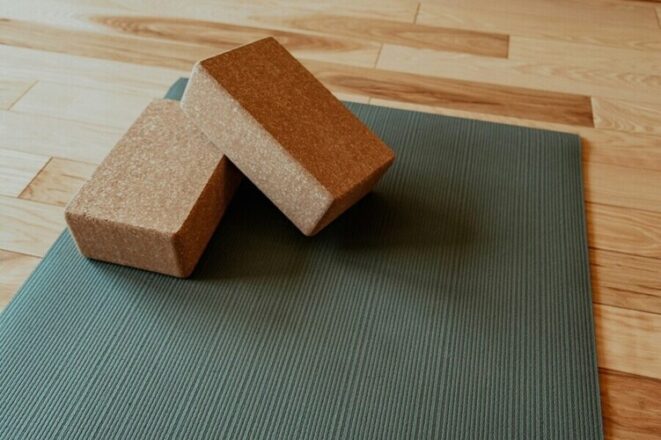7 Side Effects of Aerial Yoga and How to Make Aerial Yoga Enjoyable
- Posted on
Jennie T.
- 0
- Categories: Blog,Aerial Yoga

Introduction
If you have been curious about “what are the side effects of aerial yoga?”, I have you covered. Aerial yoga or anti-gravity yoga is a combination of traditional yoga poses on a silk hammock. Many of aerial yoga poses are inverted. Besides some significant benefits of inversion exercises, aerial yoga also has a number of side effects. We’ll look into them one by one in this article.
7 Side Effects of Aerial Yoga
You can listen to the article, scroll down to the article title episode and click play:
1. Dizziness and Motion Sickness

The number one side effect of aerial yoga is dizziness and motion sickness. Your body is not used to physically being suspended mid-air without grounding, and the balance of your physical orientation will change, leading to discomfort and nausea. Due to your vestibular system being disrupted, aerial yoga poses can especially trigger the nervous system. You will find this more common if you have vertigo or inner ear problems, as you might be more likely to feel these side effects.
2. Muscle Strain and Overuse

There is a potential risk of muscle strain and overuse, as balancing in the air requires core engagement and the correct form. Not using the correct posture can lead to further injury, as weight is distributed to the wrong areas, which leads to further exertion and strain. Aerial yoga, done incorrectly can especially lead to potential shoulders, arms, and back injuries. The challenge for you, after you can do the pose, is to maintain the form correctly to maintain the balance weight on your muscles.
3. Risk of Falls and Impact Injuries

You are at the risk of falling and injuring yourself, suspended in the fabric. Many beginners in aerial yoga often lack balance and coordination at the start of their journey, increasing their risk of falls. Falling from an aerial yoga swing and hitting the ground can lead to impact injuries, bruises, to fractures, depending on how you and your limbs land. The risk of falling directly on the head is very high, and further accidents may occur without supervision.
4. Force on the Spine

Traction and spine decompression in aerial yoga pose risks for those with pre-existing spinal conditions. If you have a herniated disc or spondylolisthesis, the force on your spine can lead to more complications and harm to the health of your spine. While spinal decompression may offer others benefits, it’s important to be aware of your spine’s unique conditions, so you don’t end up unintentionally harming yourself.
5. Increased Intraocular and Intra-Abdominal Pressure

This aerial practice can temporarily increase pressure in the body at certain places, which can create health concerns if not addressed. The wrong pressure in the right place can cause problems, as well as the right amount of pressure in the wrong place. With all the blood flowing to the head during inversions, this can cause extra stress for anyone who has had eye surgery, glaucoma, or pre-existing eye conditions.
Moreover, it’s important for you to consult a professional to see the potential health risks of an inverted position and if it’s safe for you to absorb the intra-ocular pressure. The same goes for the abdominal muscles, where blood constantly flows towards.
Similarly, some aerial yoga poses utilize core muscles intensely, and this increases intra-abdominal pressure, which can lead to pelvic floor dysfunction for those who are predisposed to it already. Commonly, some people find their core sore from practicing after a session, but others might push it too far. It’s important to distinguish between well-practiced muscles and those that are strained.
In addition to this, the strain can affect more than your muscles, such as your nerves. Nerves can get compressed due to the pressure from yoga leading to tingling or numbness, tingling, or pain in various body parts. Remember, during aerial yoga, you must be aware of your own body to fully understand how much potential risk for harmful side effects your practice entails.
6. Skin Abrasions and Bruising

The fabric of the hammocks or silk in aerial yoga may pull against your skin, causing bruising, irritation, and abrasions where it makes contact. If you have sensitive skin, it’s important to check the fabric’s condition and cleanliness to reduce the risk of a reaction of a breakout or bruising. With the pressure of the fabric holding your whole body weight, you should be mindful, as your skin will be tightly grasped against the folds of the silk as it may cause irritation.
I’ve observed, that many people with sensitive skin or certain skin conditions might feel sore or notice a rash developing if they’re allergic to the fabric used for the ropes.
7. Psychological Stress and Anxiety

Lastly, aerial yoga can trigger a reasonable amount of anxiety or stress if you have a fear of heights or being trapped. As the cloth wraps and knots around the body to suspend you, it can trigger you by bringing forward a similar sensation in the feeling of being stuck or tied. Aerial yoga could bring you psychological stress and anxiety, particularly when attempting challenging poses that require lifting yourself up to the top of the rope and suddenly you’ll have to work on overcoming a fear of heights.
Things to Do to Make Aerial Yoga More Enjoyable
1. Eat Light

Try not to eat a heavy meal before your aerial yoga class, as this can cause digestive discomfort and even sluggishness. Having a full stomach can increase the likelihood of nausea, especially during inversions and spins.
Subsequently, to balance our your energy levels, consider having a light snack at least 1-2 hours before the session. I don’t need you to completely starve.However if swinging in the air gets you feeling a little sick at first, it’s okay to take a break. It takes time for the body to get used to the orientation of being suspended mid-air.
2. Follow Your Body’s Cue

Firstly, don’t overexert yourself. Remember that aerial yoga is a practice of meditation, flexibility, and exercise. Take your time in between to regulate your breath and mind, if needed. It’s important not to push your body beyond its limits. If you feel like stopping and taking time in a pose, it’s completely okay to do so.
Secondly, I’ve seen many people, out of shame, push themselves to follow the flow of the class, with the fear they’ll be left behind, and tire out their bodies. This is not a competition or a race. It’s important to you to give yourself time to adjust and remember to stay present with your own experience. Take time to notice the sensations in your body, as they will help you understand where your flexibility and mobility will need work.
3. Engage Your Core

Practicing your core exercises will help. For those who plan on doing aerial yoga long term, building your core strength in exercises otherwise can be greatly beneficial in holding poses for your class. Aerial yoga poses focus on core strength and flexibility while holding you up weightless against the fabric. If these muscles are exercised otherwise, it can bring greater ease to the practice. This practice works with all stiff parts of your body, as it eases into them being more flexible.
In addition to this, if you find yourself struggling to do a certain pose, only because one side of your body is less flexible, try stretching it to build flexbility. Take extra stretching exercises to encourage joints with more stretchability and range. It’s important for you to have the right balance of weight on both sides of the body.
4. Make Sure You’re Comfortable

Do not wear loose-fitted clothing, as these can get caught in the fabric to get tangled up. Ill-fitted clothing can also cause burn or chafing for your skin. Wearing tight-fitted clothes that are also stretchy will allow for less risk of surface friction and entanglement when you move along with the poses.
Moreover, the fabric you’re suspending yourself with, will also need to be adjusted. Make sure the silk fabric or rope is hung at the right height for you, and if not, get it adjusted by your instructor. I suggest using a soft padded yoga mat underneath in case you fall. As for help with some of the poses, you can use yoga bricks to give you an additional height or stretch.
Above all, communication is the key to a more enjoyable yoga practice here. If while practicing, something is painful or uncomfortable, it’s important to reach out and discuss with your aerial yoga teacher to help you find the perfect placement. Communicate with your body as well. Listen and trust your body. You can rest if your head gets dizzy or even ask for accommodations for different poses that are adding too much stress to your joints. If something doesn’t feel right with you, ask for assistance. Do not be afraid of taking a break, either.
5. Let Yourself Enjoy

Remember to have fun. Taking time to enjoy what you do is an underrated practice, but it definitely makes the process of learning easier. Take selfies in poses that look interesting, listen to music that makes you feel revitalized, play around in the fabric, or even imagine that you’re a bird in the air. Imagine you’re a literal butterfly coming out of the cocoon pose. I encourage people to lettheir inner child come out when they’re in the air. Indulging in your playful side will bring you greater joy.
Furthermore, when it comes to making yoga more enjoyable, trusting yourself is an important and major part of the process of pleasure. I believe once you attune yourself to your body and place faith in the process, the practice will be much more upliftingfor your mood. By trusting your body, the fabric, and your teacher, it will be easier to relax and participate in moments of learning. The more patient and understanding you are of your limitations, the better of an experience it will be. Getting tangled or even confused is part of the learning experience and should be taken in stride. Rather than looking around and comparing yourself to others, focus on your individual progress and success.
Conclusion
In the end, once you know better, you can do better. It helps to be prepared by knowing the negative side effects and how to make this aerial practice more suitable for your well-being. This way, you can make an informed decision that protects your health in the long run
Want to learn more about aerial yoga? Here are a number of topics you may want to check out:
Jennie T.
Jennie is a long time yogi, a vegetarian and a blogger. Her morning routine starts with a glass of lukewarm lemon water, 1-hour yoga or cardio exercise, then an organic smoothie, and a cup of green tea or milk tea. Besides yoga and blogging, she likes to meditate in the morning or at lunch break. She is a Seinfeld's fan (sorry Friends)
all author postsRelated posts
Debunk Top 9 Yoga Myths | Yoga Q&A
- Posted on
- 0
How To Become Flexible With Yoga | Yoga Q&A
- Posted on
- 0
How To Tone Your Body With Yoga | Yoga Q&A
- Posted on
- 0






